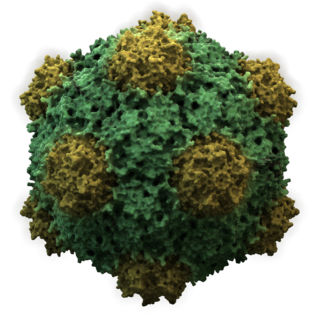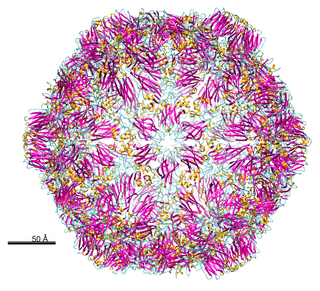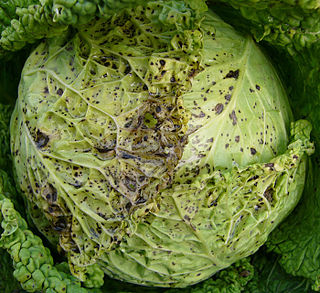Closteroviridae is a family of viruses. Plants serve as natural hosts. There are currently 56 species in this family, divided among 4 genera, seven species of which are unassigned. Diseases associated with this family include: yellowing and necrosis, particularly affecting the phloem.*

Comovirinae is a subfamily of viruses in the order Picornavirales, in the family Secoviridae; its genera were formerly classified in the family Comoviridae. Plants serve as natural hosts. There are currently 62 species in this subfamily, divided among 3 genera.

Potyvirus is a genus of viruses in the family Potyviridae. Plants serve as natural hosts. There are currently 183 species in this genus including the type species Potato virus Y. The genus is named after the type virus. Potyviruses account for ~30% of the currently known plant viruses. Like begomoviruses, members of this genus may cause significant losses in agricultural, pastoral, horticultural and ornamental crops. More than 200 species of aphids spread potyviruses and most are from the subfamily Aphidinae.

Begomovirus is a genus of viruses, in the family Geminiviridae. They are plant viruses that as a group have a very wide host range, infecting dicotyledonous plants. Worldwide they are responsible for a considerable amount of economic damage to many important crops such as tomatoes, beans, squash, cassava and cotton. There are currently 424 species in this genus including the type species Bean golden yellow mosaic virus.

Nepovirus is a genus of viruses in the order Picornavirales, in the family Secoviridae, in the subfamily Comovirinae. Plants serve as natural hosts. There are currently 40 species in this genus including the type species Tobacco ringspot virus. Nepoviruses, unlike the other two genera in the subfamily Comovirinae, are transmitted by nematodes.
African cassava mosaic virus is a plant pathogenic virus of the family Geminiviridae that may cause either a mosaic appearance to plant leaves, or chlorosis, a loss of chlorophyll. In Manihot esculenta (cassava), a highly valuable African food crop, the virus causes severe mosaic. Cassava is a staple food crop in many places throughout the tropics and subtropics as a source of carbohydrates, but the transmission and severity of disease for cassava in Africa is greatest with ACMV.

Cassava mosaic virus is the common name used to refer to any of eleven different species of plant pathogenic virus in the genus Begomovirus. African cassava mosaic virus (ACMV), East African cassava mosaic virus (EACMV), and South African cassava mosaic virus (SACMV) are distinct species of circular single-stranded DNA viruses which are transmitted by whiteflies and primarily infect cassava plants; these have thus far only been reported from Africa. Related species of viruses are found in India and neighbouring islands, though cassava is cultivated in Latin America as well as Southeast Asia. Nine species of cassava-infecting geminiviruses have been identified between Africa and India based on genomic sequencing and phylogenetic analysis. This number is likely to grow due to a high rate of natural transformation associated with CMV.
Bean yellow mosaic virus is a plant pathogenic virus in the genus Potyvirus and the virus family Potyviridae. Like other members of the Potyvirus genus, it is a monopartite strand of positive-sense, single-stranded RNA surrounded by a capsid made for a single viral encoded protein. The virus is a filamentous particle that measures about 750 nm in length. This virus is transmitted by species of aphids and by mechanical inoculation.
Cassava common mosaic virus (CsCMV) is a plant pathogenic virus.
Indian cassava mosaic virus(ICMV) is a plant pathogenic virus of the family Geminiviridae. It affects cassava in India and certain other countries. It is considered to be an invasive species.
Red clover vein mosaic virus (RCVMV) is a plant pathogenic virus.
Carlavirus, formerly known as the "Carnation latent virus group", is a genus of viruses in the order Tymovirales, in the family Betaflexiviridae. Plants serve as natural hosts. There are currently 53 species in this genus including the type species Carnation latent virus. Diseases associated with this genus include: mosaic and ringspot symptoms.
Malva vein clearing virus also known as MVCV is a species of Potyvirus in the family Potyviridae that was isolated in 1957 from Malva sylvestris in Germany which is transmitted by the aphids Aphis umbrella and Myzus persicae. The insects mechanically inoculate the malvaceous hosts.

Secoviridae is a family of viruses in the order Picornavirales. Plants serve as natural hosts. There are currently 86 species in this family, divided among 8 genera or not assigned to a genus. The family was created in 2009 with the grouping of families Sequiviridae, now dissolved, and Comoviridae, now subfamily Comovirinae, along with the then unassigned genera Cheravirus, Sadwavirus, and Torradovirus.
Cassava brown streak virus disease (CBSD) is a damaging disease of cassava plants, and is especially troublesome in East Africa. It was first identified in 1936 in Tanzania, and has spread to other coastal areas of East Africa, from Kenya to Mozambique. Recently, it was found that two distinct viruses are responsible for the disease: cassava brown streak virus (CBSV) and Ugandan cassava brown streak virus (UCBSV). Both have (+)ss RNA genomes, belong to the genus Ipomovirus in the family Potyviridae, and produce generally similar symptoms in infected plants. Root rot renders the cassava tuber inedible, resulting in severe loss of economic value; therefore, current research focuses on achieving cultivars that do not develop the necrotic rot. This disease is considered to be the biggest threat to food security in coastal East Africa and around the eastern lakes.
Ipomovirus is a genus of viruses, in the family Potyviridae. There are currently seven species in this genus including the type species Sweet potato mild mottle virus. They infect plants and are transmitted by whiteflies. The name of the genus is derived from Ipomoea - the generic name of sweet potato.

Caulimovirus is a genus of viruses, in the family Caulimoviridae order Ortervirales. Plants serve as natural hosts. There are currently 13 species in this genus including the type species Cauliflower mosaic virus. Diseases associated with this genus include: vein-clearing or banding mosaic.
Cavemovirus is a genus of viruses, in the family Caulimoviridae order Ortervirales. Plants serve as natural hosts. There are currently only two species in this genus including the type species Cassava vein mosaic virus. Diseases associated with this genus include: vein-clearing or banding mosaic.

Tymovirus is a genus of viruses in the order Tymovirales, in the family Tymoviridae. Plants serve as natural hosts. There are currently 28 species in this genus including the type species Turnip yellow mosaic virus.






